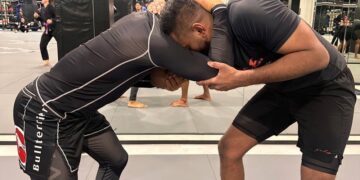
Working around the opponent’s guard may seem tricky, especially when trying to pass standing. As Brazilian Jiu-Jitsu evolves, dealing with different leg entanglements, enabling sweeps, and leading to submissions can be frustrating. While getting past the opponent’s line of defense is challenging, knowing when to stay tight or loose is critical when passing the guard. This article will introduce you to high-step passing in BJJ.
The High Step Pass
The high step pass is a guard passing technique used to step around the opponent’s guard while effectively controlling their hips and limbs to minimize the risk of counterattacks. It allows you to safely get past the opponent’s legs, lessening your susceptibility to leg attacks and different attacks from the guard.
First, let’s discuss the various high-step variants you can do. Typically, the high-step movement can be used to get out of the opponent’s initial guard set-ups, out of leg entanglements, and to disengage from hooks.
The basic high-step movement is like the hip opener we perform during warm-ups, where you move your feet and knees up and out. This movement can be effectively used to get out of guards like the reverse De La Riva and shin to shin. However, while doing this movement, remember that when your leg is up doing a high step, your other leg is vulnerable to attacks.
If the opponent decides to wrestle up and goes for your leg, you can look away, kick out, and high step while posting on their face. When doing this disengagement, actively move out from the single leg as timidly doing so exposes you to a takedown if the opponent decides to chase you and your back, which the opponent can capitalize on to get a superior position. Remember to post on the opponent’s head before high-stepping and looking away.
Another way the high step can be used is to high step through the guard and land on the knee on the belly position, especially when the opponent has De La Riva hooks established. Also, it can be used to get past the DLR and land to the north-south instead of stepping laterally. If the opponent has a reverse DLR, instead of putting pressure and doing a knee cut on their reverse DLR leg, you can post your hand on the mat and step over their top leg. The same can also be applied if the opponent uses a butterfly hook.
High Step To Counter The Wrestle-Up
A common reaction from opponents once you high step through is they try to wrestle up. Start grabbing the opponent’s ankle and knee from the supinated open guard going to their left. Take a shallow step towards their center line and step up with your left leg, thereby hitting a front pummel, and push the opponent’s near knee away, stepping near their hip pocket.
From this position, opponents usually grip your far ankle and use their outside leg like a pendulum so that they can start wrestling up. As the opponent wrestles up, look to start stuffing their head in between your legs. From here, start shooting your left elbow across their hips, and as they try to continue and wrestle up, start sprawling your right leg back. After sprawling, slide your right shin behind the opponent and begin taking their back.
High Step Pass Against Reverse De La Riva
Assuming you’re passing the guard towards your left side, and the opponent establishes a reverse De La Riva while grabbing your ankle. Typically, the opponent will try to establish a connection. Doing so will most likely open up a space between their elbow and knee. The space above the hipline is what Gordon Ryan refers to as the J-Point (Jeopardy Point), as it is the point where the opponent must address your passing actions as they will be in jeopardy of getting their guard passed.
Capitalize the space between the opponent’s elbow and knee and get into a high-step position. Straighten your trapped leg (right leg) while controlling the opponent’s knee using your left hand and their far leg using your right hand. Step to the left side past the opponent’s knee while maintaining a C-grip on their far leg. Pinch your knees together and post your left arm on their far shoulder for stability and to prevent the opponent from wrestling up.
You deny the opponent’s ability to step their leg over your shoulder from this position, meaning they cannot retain the guard or enter leg locks. Your left hand that’s posted on their shoulder prevents the opponent from slowly turning to their knees to wrestle up, and pinching your knees limits the opponent’s space to initiate leg attacks.
Slowly lift your right foot up into the opponent’s near hip pocket. Once you’ve pummeled your right foot out, you can secure a knee on the belly pin by bringing your legs together while maintaining the grip on the opponent’s far leg or posting to the far hip. You can also move to the north-south position and secure the pass.
If the opponent has a loose grip on your ankle, you can directly go for a high step pass and pummel your leg up to their hip pocket. A key detail when passing with the high step is the control over the opponent’s far leg using a C-grip, as without it, the opponent can quickly enter into leg entanglements and attack with leg locks. Likewise, if the opponent turns while pinned with the knee on the belly, you can do a top spin and take their back as they turtle.
Conclusion
The high-step pass is a systematic and modern way to pass the opponent’s guard, as the legs are more vulnerable to leg attacks when passing the guard standing. It effectively neutralizes guards that lead to leg entanglements and leg locks, which are a must-learn to defend, especially in the current meta of No-Gi BJJ. Study the high-step pass and see how it fits your passing game.
You may also like:
8 Most Efficient Submissions For Older Grapplers
Brazilian Jiu-Jitsu advocates the philosophy that technique and intelligence can overcome brute strength and explosiveness, making it an inclusive martial art for enthusiasts of all ages. This principle particularly resonates with older grapplers, who, while…
Leg locks have been dominating the grappling scene for the past few years. To become competitive in modern BJJ, grapplers need to familiarize themselves with the different leg lock positions to build their offensive and…
Working from the guard position is one of the most fundamental skills you must master in Brazilian Jiu-Jitsu. BJJ is a martial art that heavily emphasizes utilizing the guard for offensive and defensive purposes. The…
So you’ve finally followed through and signed up for a BJJ class in Singapore. The next step is to attend your first training session. It’s normal to feel a bit anxious about your first day…
Every BJJ match starts with the standup and is followed by closing the distance. In grappling, the first physical contact we make with the opponent is establishing our grips. Strong grips allow grapplers to work…
In Brazilian Jiu-Jitsu, a great opponent is the one that is difficult to submit. A good defense creates a pathway to offense. As the idea of position before submission is critical, submissions are usually executed…
Kicks are one of the most powerful tools you have at your disposal in mixed martial arts so you should spend as much time working on them as you do practicing your punching techniques. One-dimensional…
In many combat sports, fans and fighters alike seem to be obsessed with immaculate records. Ever since legendary boxer Rocky Marciano retired undefeated in 1955 with 49 straight wins, fans in the West have been…
The sport of boxing has struggled a bit in the past couple of decades, but it has been able to make a resurgence in recent times thanks to the many captivating personalities, thrilling matchups, and…
Having a strong lower back helps with injury prevention, mobility, and stability as you go about your daily activities or partake in sports and even work out. Everyone benefits from having stronger lower back muscles…
In the heart of Singapore, where modernity meets tradition, martial arts stand as a testament to a timeless pursuit of excellence. Beyond the bustling streets and towering skyscrapers, learning martial arts offers more than a…
In the Muay Thai scene, Buakaw Banchamek, whose birth name is Sombat Banchamek, is a legendary Nak Muay with two hundred and eighty fights to his name. Some of his accolades include being a two-time…


































